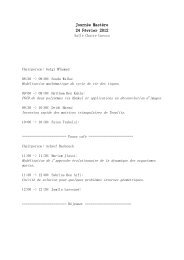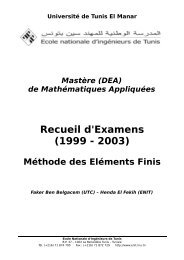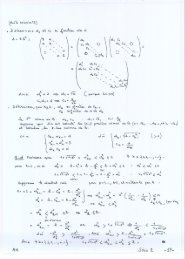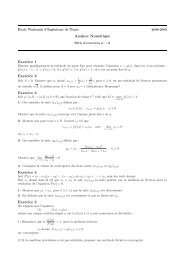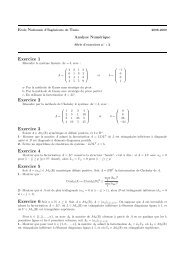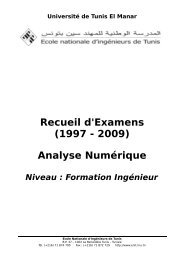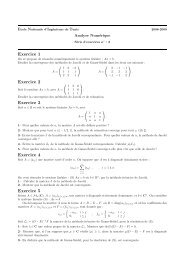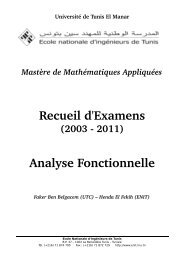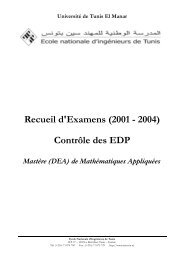- Page 5 and 6:
PréfaceOrganiser la seconde éditi
- Page 7:
Comité d’organisationMohamed Abd
- Page 11 and 12:
SOMMAIRE / CONTENTSI Conférences I
- Page 13 and 14:
Equilibre dans un système dynamiqu
- Page 15 and 16:
Arlequin method: Practical impacts
- Page 17 and 18:
Application de la méthode de Gauss
- Page 19:
Conférences InvitéesInvited Prese
- Page 22 and 23:
4 Amara et al.1. IntroductionWe are
- Page 24 and 25:
6 Amara et al.2.2. The nonlinear Na
- Page 26 and 27:
8 Amara et al.4. Numerical resultsW
- Page 28 and 29:
10 Auger et al.1. Introduction :Dan
- Page 30 and 31:
12 Auger et al.La condition de stab
- Page 32 and 33:
14 Auger et al.3.1. Taux de migrati
- Page 34 and 35:
16 Auger et al.L’équilibre rapid
- Page 36 and 37:
18 Auger et al.[7] BRAVO DE LA PARR
- Page 38 and 39:
Quelques aspects mathématiques etn
- Page 40 and 41:
22 El Alaoui Talibi M.- Modèle d
- Page 42 and 43:
24 El Alaoui Talibi M.[3] M. Chamba
- Page 44 and 45:
26 Habbal1. IntroductionAngiogenesi
- Page 46 and 47:
28 HabbalThe pressure drop denoted
- Page 48 and 49:
30 Habbaltheorem 1 There exists a N
- Page 50 and 51:
32 HabbalFigure 2. Second Nash loop
- Page 52 and 53:
34 Hauray et al.1. IntroductionWe a
- Page 54 and 55:
36 Hauray et al.minimal time interv
- Page 56 and 57:
38 Hauray et al.From this last theo
- Page 58 and 59:
Approximation de l’opérateur d
- Page 60 and 61:
42 LemrabetLorsque δ → 0, l’é
- Page 62 and 63:
44 Lemrabetavec[∆ ∗ (δ)c = [I
- Page 64 and 65:
46 Lemrabet6. Bibliographie[1] N. B
- Page 66 and 67:
48 Jaafar-Belaid et al.1. Introduct
- Page 68 and 69:
50 Jaafar-Belaid et al.where f(ρ)
- Page 70 and 71:
52 Jaafar-Belaid et al.202040406060
- Page 73:
IIContrôleControl55
- Page 76 and 77:
58 Arfaoui1. IntroductionCe travail
- Page 78 and 79:
60 ArfaouiLe système adjoint assoc
- Page 80 and 81:
62 Arfaoui[3] H. ARFAOUI , « Comma
- Page 82 and 83:
64 Benzekri et al.1. Global control
- Page 84 and 85:
66 Benzekri et al.ẏ = ∂H∂x =
- Page 86 and 87:
0 1 2 3 4 5 668 Benzekri et al.32.5
- Page 88 and 89:
70 Akian et al.1. IntroductionWe co
- Page 90 and 91:
72 Akian et al.We prove that v t+δ
- Page 92 and 93:
.74 Akian et al.0.0−1.0Exact solu
- Page 94 and 95:
76 Bokanowski et al.1. General fram
- Page 96 and 97:
78 Bokanowski et al.One interesting
- Page 98 and 99:
80 Bokanowski et al.4. Numerical ex
- Page 100 and 101:
Sur les problèmes de contrôle opt
- Page 102 and 103:
84 Metouileur lorsque u est dans L
- Page 104 and 105:
86 MetouiThéorème 2 Soit ū ε le
- Page 106 and 107:
88 Metoui[5] L.S. HOU, S.S. RAVINDR
- Page 109 and 110:
Système d’information intégré
- Page 111 and 112:
Gestion et modélisation des ressou
- Page 113 and 114:
Gestion et modélisation des ressou
- Page 115 and 116:
Gestion et modélisation des ressou
- Page 117 and 118:
Gestion et modélisation des ressou
- Page 119 and 120:
Gestion et modélisation des ressou
- Page 121 and 122:
Gestion et modélisation des ressou
- Page 123 and 124:
Random perturbations of reduced gra
- Page 125 and 126:
Global Optimization of Water Resour
- Page 127 and 128:
Global Optimization of Water Resour
- Page 129:
IVEquations DifférentiellesDiffere
- Page 132 and 133:
114 B. Abdelkader1. IntroductionTel
- Page 134 and 135:
116 B. AbdelkaderNotons que les con
- Page 136 and 137:
118 B. AbdelkaderAlors pour tout X
- Page 138 and 139:
120 Bouzahir1. IntroductionWe consi
- Page 140 and 141:
122 Bouzahirwhere the linear operat
- Page 142 and 143:
Goursat boundary value problem forh
- Page 144 and 145:
126 A. Guezane-Lakoud et al.3. Func
- Page 146 and 147:
128 A. Guezane-Lakoud et al.5. Exis
- Page 148 and 149:
ACP neuronale : application à l’
- Page 150 and 151:
132 Chitroubl’approximation de la
- Page 152 and 153:
134 Chitroubcompression égal à 3.
- Page 154 and 155:
136 Chitroub[4] J. P. Nougier, Mét
- Page 156 and 157:
138 Ferchichi et al.1. Introduction
- Page 158 and 159:
140 Ferchichi et al.soit T −1 = (
- Page 160 and 161:
142 Ferchichi et al.[4] G.I. BISCHI
- Page 162 and 163:
144 Hafidi1. IntroductionOn étudie
- Page 164 and 165:
146 Hafidia ) ∫ Ωpdx → +∞ qu
- Page 166 and 167:
148 HafidiLEMME 3.2. On a lim R(θ
- Page 168 and 169:
150 Lefebvre1. IntroductionSoit (X
- Page 170 and 171: 152 LefebvreOn peut aussi écrire q
- Page 172 and 173: 154 Lefebvre5. BibliographieD.R. Co
- Page 174 and 175: 156 Meskine1. IntroductionDans le p
- Page 176 and 177: 158 Meskinefaibles σ( ∏ L M ,
- Page 178 and 179: 160 Meskine[12] E. YA. KHRUSLOV, L.
- Page 180 and 181: 162 K. Saoudi1. IntroductionL’ét
- Page 182 and 183: 164 K. Saoudice qui montre que la s
- Page 184 and 185: 166 K. Saoudieton aboutit au résul
- Page 186 and 187: 168 K. Saoudietc 1 + c 2 = 1 ∫(u
- Page 188 and 189: 170 K. SaoudiRemarque 3.1. Du lemme
- Page 190 and 191: 172 K. Saoudiet∫v(t, x) dxΩest c
- Page 193: VEstimation d’ErreursError Estima
- Page 196 and 197: 178 Achchab et al.1. IntroductionDu
- Page 198 and 199: 180 Achchab et al.such that}Xh 2 ={
- Page 200 and 201: 182 Achchab et al.[2] B.ACHCHAB, M.
- Page 202 and 203: 184 Alla et al.1. IntroductionLes e
- Page 204 and 205: 186 Alla et al.3. Position du probl
- Page 206 and 207: IsoValue-0.00070533-0.000604452-0.0
- Page 208 and 209: 190 Achchab et al.1. IntroductionLe
- Page 210 and 211: 192 Achchab et al.où T hi/2 est le
- Page 212 and 213: IsoValue0.000933570.002800710.00840
- Page 214 and 215: 196 El Dabaghi et al.1. Motivation
- Page 216 and 217: 198 El Dabaghi et al.0 ≤ λ i ≤
- Page 218 and 219: 200 El Dabaghi et al.Figure 4. Mail
- Page 222 and 223: 204 Kharrat et al.The step (3) need
- Page 224 and 225: 206 Kharrat et al.following estimat
- Page 227: VIMécanique des FluidesFluid Mecha
- Page 230 and 231: 212 Abdelwahed et al.1. Introductio
- Page 232 and 233: 214 Abdelwahed et al.Ainsi, suivre
- Page 234 and 235: 216 Abdelwahed et al.Figure 3. Isov
- Page 236 and 237: Procédure spectrale avec diagonali
- Page 238 and 239: 220 El Guarmah et al.où Ra et P r
- Page 240 and 241: 222 El Guarmah et al.M 10 20 25 35
- Page 242 and 243: Simulation de l’onde de crue via
- Page 244 and 245: 226 El Dabaghi et al.de R 2 , de fr
- Page 246 and 247: 228 El Dabaghi et al.INRIA-MODULEFm
- Page 248 and 249: INRIA-MODULEF230 El Dabaghi et al.I
- Page 250 and 251: 232 Amoura et al.1. IntroductionFor
- Page 252 and 253: 234 Amoura et al.where u = rot r ψ
- Page 254 and 255: 236 Amoura et al.CURRENT FUNCTION5
- Page 256 and 257: 238 Frih et al.1. IntroductionLa mo
- Page 258 and 259: 240 Frih et al.et dans la fracture,
- Page 260 and 261: 242 Frih et al.6. Bibliographie[1]
- Page 262 and 263: 244 Hasnaoui et al.1. IntroductionL
- Page 264 and 265: 246 Hasnaoui et al.On obtient alors
- Page 266 and 267: 248 Hasnaoui et al.5. Conclusion et
- Page 268 and 269: 250 Hernane-Boukari1. IntroductionW
- Page 270 and 271:
252 Hernane-Boukarianda 3 =−11 +
- Page 272 and 273:
254 Kloucha et al.1. Motivation et
- Page 274 and 275:
256 Kloucha et al.Si le domaine Λ
- Page 276 and 277:
INRIA-MODULEF0INRIA-MODULEF.250INRI
- Page 278 and 279:
Dimensions fractales : attracteurs
- Page 280 and 281:
262 Lamrini Uahabi et al.4. Attract
- Page 282 and 283:
264 Lamrini Uahabi et al.l 0 = λ
- Page 284 and 285:
266 Lamrini Uahabi et al.En conséq
- Page 286 and 287:
Numerical analysis for the problem
- Page 288 and 289:
270 El-Kyal et al.d(u) = 1 2(∇u +
- Page 290 and 291:
272 El-Kyal et al.Theorem 3.1 There
- Page 292 and 293:
274 Marchand et al.1. IntroductionD
- Page 294 and 295:
276 Marchand et al.On remarque en p
- Page 296 and 297:
278 Marchand et al.dans la formulat
- Page 298 and 299:
280 Mezali et al.1. Motivation et m
- Page 300 and 301:
282 Mezali et al.s’annulant sur c
- Page 302 and 303:
284 Mezali et al.Temps CPUTemps Ela
- Page 304 and 305:
R. Touihri & S. Ghnimi *Méthode de
- Page 306 and 307:
288 Touihri et al.Les équations go
- Page 308 and 309:
290 Touihri et al.Tol N It (Newt) t
- Page 310 and 311:
292 Touihri et al.5. Bibliographie[
- Page 313 and 314:
Décomposition de domaine pour un m
- Page 315 and 316:
DDM pour les fractures 297et−→
- Page 317 and 318:
DDM pour les fractures 299dont l’
- Page 319 and 320:
Arlequin method: Practical impacts
- Page 321 and 322:
Arlequin method 303of the Arlequin
- Page 323 and 324:
Arlequin method 3052.2. Penalized A
- Page 325 and 326:
Arlequin method 307refinements of t
- Page 327 and 328:
Reduction methods and uncertaintypr
- Page 329 and 330:
Reduction methods and uncertainty p
- Page 331 and 332:
Reduction methods and uncertainty p
- Page 333 and 334:
0.00e+00 1.00e−11 2.00e−11 3.00
- Page 335 and 336:
Homogénéisation d’un problème
- Page 337 and 338:
Problème de conduction-rayonnement
- Page 339 and 340:
Problème de conduction-rayonnement
- Page 341 and 342:
Equation d’Hamilton-Jacobi 3231.
- Page 343 and 344:
Equation d’Hamilton-Jacobi 325qui
- Page 345 and 346:
0Equation d’Hamilton-Jacobi 3272
- Page 347 and 348:
Détermination du nombre de région
- Page 349 and 350:
Détermination du nombre de région
- Page 351 and 352:
Détermination du nombre de région
- Page 353 and 354:
Simulation des courants de Foucault
- Page 355 and 356:
Simulation des courants de Foucault
- Page 357 and 358:
Simulation des courants de Foucault
- Page 359 and 360:
Une méthode d’accélération de
- Page 361 and 362:
Une méthode d’accélération de
- Page 363 and 364:
Une méthode d’accélération de
- Page 365 and 366:
Une méthode d’accélération de
- Page 367 and 368:
Schéma SRNHS 3491. IntroductionUn
- Page 369 and 370:
Schéma SRNHS 3513. Application du
- Page 371 and 372:
Schéma SRNHS 3535. ConclusionLes r
- Page 373 and 374:
Smoothing and compressing surfaces
- Page 375 and 376:
Smoothing and compressing surfaces
- Page 377 and 378:
Smoothing and compressing surfaces
- Page 379 and 380:
Problème de convection en milieu p
- Page 381 and 382:
0 0.1 0.2 0.3 0.4 0.5 0.6 0.7 0.8 0
- Page 383 and 384:
Condensation de masse pour la méth
- Page 385 and 386:
Condensation de masse 367montre que
- Page 387 and 388:
Condensation de masse 369Le terme h
- Page 389 and 390:
Condensation de masse 371Aet Qile f
- Page 391:
VIIIModèles CinétiquesKinetic Mod
- Page 394 and 395:
376 Ben Abdallah et al.1. Introduct
- Page 396 and 397:
378 Ben Abdallah et al.where B ∓
- Page 398 and 399:
380 Ben Abdallah et al.ture that th
- Page 400 and 401:
382 Degond et al.1. IntroductionOn
- Page 402 and 403:
384 Degond et al.q φ s (x, t)/(|q|
- Page 404 and 405:
386 Degond et al.Enfin l’opérate
- Page 407 and 408:
Les métaheuristiques : application
- Page 409 and 410:
Les métaheuristiques 391simulé fu
- Page 411 and 412:
Les métaheuristiques 393Fig. 1 Dia
- Page 413 and 414:
Les métaheuristiques 395Fig.4 : R
- Page 415 and 416:
Prices after capacity addition in m
- Page 417 and 418:
Multi-user elastic demand communica
- Page 419 and 420:
Multi-user elastic demand communica
- Page 421 and 422:
Multi-user elastic demand communica
- Page 423 and 424:
Shape optimization 4051. Introducti
- Page 425 and 426:
Shape optimization 4072.1. Variatio
- Page 427 and 428:
Shape optimization 409(a)(b)(c)(d)F
- Page 429 and 430:
Problèmes d’optimisation en éco
- Page 431 and 432:
Problèmes d’optimisation en éco
- Page 433:
Problèmes d’optimisation en éco
- Page 437 and 438:
Assimilation de données pour l’e
- Page 439 and 440:
Assimilation de données pour l’e
- Page 441 and 442:
Assimilation de données pour l’e
- Page 443 and 444:
Écart à la Réciprocité et ident
- Page 445 and 446:
Identification de fissures planes 4
- Page 447 and 448:
Identification de fissures planes 4
- Page 449 and 450:
Identification de fissures planes 4
- Page 451 and 452:
Algorithme de Kohn et Vogelius 4331
- Page 453 and 454:
Algorithme de Kohn et Vogelius 435l
- Page 455 and 456:
Algorithme de Kohn et Vogelius 4375
- Page 457 and 458:
Résolution d’un problème de Cau
- Page 459 and 460:
Résolution d’un problème de Cau
- Page 461 and 462:
Résolution d’un problème de Cau
- Page 463 and 464:
Problème inverse géométrique 445
- Page 465 and 466:
Problème inverse géométrique 447
- Page 467 and 468:
Problème inverse géométrique 449
- Page 469 and 470:
Identification de fissures 4511. In
- Page 471 and 472:
−0.5 −0.4 −0.3 −0.2 −0.1
- Page 473 and 474:
Application de l’algorithme deNeu
- Page 475 and 476:
Complétion de données en élastic
- Page 477 and 478:
Complétion de données en élastic
- Page 479 and 480:
Analytic extensions on an annulus:a
- Page 481 and 482:
Analytic extensions on an annulus 4
- Page 483 and 484:
Analytic extensions on an annulus 4
- Page 485 and 486:
−1 −0.8 −0.6 −0.4 −0.2 0
- Page 487 and 488:
Cauchy problem for Laplace’s equa
- Page 489 and 490:
Cauchy problem for Laplace’s equa
- Page 491:
Cauchy problem for Laplace’s equa
- Page 495 and 496:
Modélisation asymptotique des onde
- Page 497 and 498:
Ondes de relief 479 uuuv 1 1 pu v
- Page 499 and 500:
Ondes de relief 481( )ˆeiZw( C e D
- Page 501 and 502:
Ondes de relief 4836. Bibliographie
- Page 503 and 504:
Régularisation pour l’aéroacous
- Page 505 and 506:
Régularisation pour l’aéroacous
- Page 507 and 508:
Régularisation pour l’aéroacous
- Page 509 and 510:
Miroir à retournement temporel 491
- Page 511 and 512:
Miroir à retournement temporel 493
- Page 513 and 514:
Miroir à retournement temporel 495
- Page 515 and 516:
Vibro-acoustique instationnaire 497
- Page 517 and 518:
Vibro-acoustique instationnaire 499
- Page 519 and 520:
Ondes dans les milieux poroélastiq
- Page 521 and 522:
Ondes dans les milieux poroélastiq
- Page 523 and 524:
Ondes dans les milieux poroélastiq
- Page 525 and 526:
The implicitly restarted Arnoldi me
- Page 527 and 528:
¨§¨ §IRAM method 509To overcome
- Page 529 and 530:
IRAM method 511The application of t
- Page 531:
XIIScience du VivantLife Science513
- Page 534 and 535:
516 Achchab1. IntroductionDans la m
- Page 536 and 537:
518 AchchabNous montrons dans le pa
- Page 538 and 539:
520 Achchab5. Bibliographie[1 ] AIE
- Page 540 and 541:
522 Derbel et al.1. IntroductionLa
- Page 542 and 543:
524 Derbel et al.On se propose de d
- Page 544 and 545:
A Stochastic partial differential e
- Page 546 and 547:
528 El Saadidiffusion process to a
- Page 548 and 549:
530 El Saadiwhere δ Xi(t) is the D
- Page 550 and 551:
532 El Saadi5. References[1] A. L.
- Page 552 and 553:
534 Ben Miled et al.1. Introduction
- Page 554 and 555:
536 Ben Miled et al.nature de l’e
- Page 556 and 557:
538 Ben Miled et al.Ensuite on étu
- Page 558 and 559:
Optimal spatial distribution of a b
- Page 560 and 561:
542 Mchich et al.at time t. The com
- Page 562 and 563:
544 Mchich et al.3∑where r = r i
- Page 565:
XIIIStructureStructure547
- Page 568 and 569:
550 Ayadi1. IntroductionConsider a
- Page 570 and 571:
552 AyadiFor all 0 ≤ p ≤ i, P p
- Page 572 and 573:
554 AyadiFigure 3. The curves above
- Page 574 and 575:
Analyse mathématique et numérique
- Page 576 and 577:
558 Chamekh et al.2. Modèle de tig
- Page 578 and 579:
560 Chamekh et al.Γ sr(s)r(σ)Figu
- Page 580 and 581:
Modélisation de l’effet dynamiqu
- Page 582 and 583:
564 RahmaniI 2 étant l’identité
- Page 584 and 585:
566 Rahmani• ( u 1δ1∫+ ,0u 1δ
- Page 586 and 587:
Résolution d’un systéme d’ela
- Page 588 and 589:
570 Saidoù u vérifie :n∑n∑j=1
- Page 590 and 591:
572 SaidEn effet :∣ u(y, s) 1+α
- Page 592 and 593:
Régularisation d’un problème d
- Page 594 and 595:
576 Achchab et al.On définit : F +
- Page 596 and 597:
578 Achchab et al.3. Estimation a p
- Page 598 and 599:
Modélisation d’un pieuR. Aboulai
- Page 600 and 601:
582 Aboulaich et al.Figure 1. Struc
- Page 602 and 603:
584 Aboulaich et al.5. Résultats n
- Page 605:
XIVThéorie des GraphesGraph Theory
- Page 608 and 609:
590 Hlaoui1. IntroductionMore and m
- Page 610 and 611:
592 Hlaoui3. The New Graph Represen
- Page 612 and 613:
594 Hlaoui1 1 2 3 4 1 1 3 411 421 4
- Page 614 and 615:
596 M. Nekri et al.1. IntroductionL
- Page 616 and 617:
598 M. Nekri et al.proposés. Ces m
- Page 618 and 619:
600 M. Nekri et al.cycle de longueu
- Page 620 and 621:
TAMTAM -Tunis- 2005 602
- Page 622 and 623:
El Guarmah, M., 218El Kacimi, A., 2



